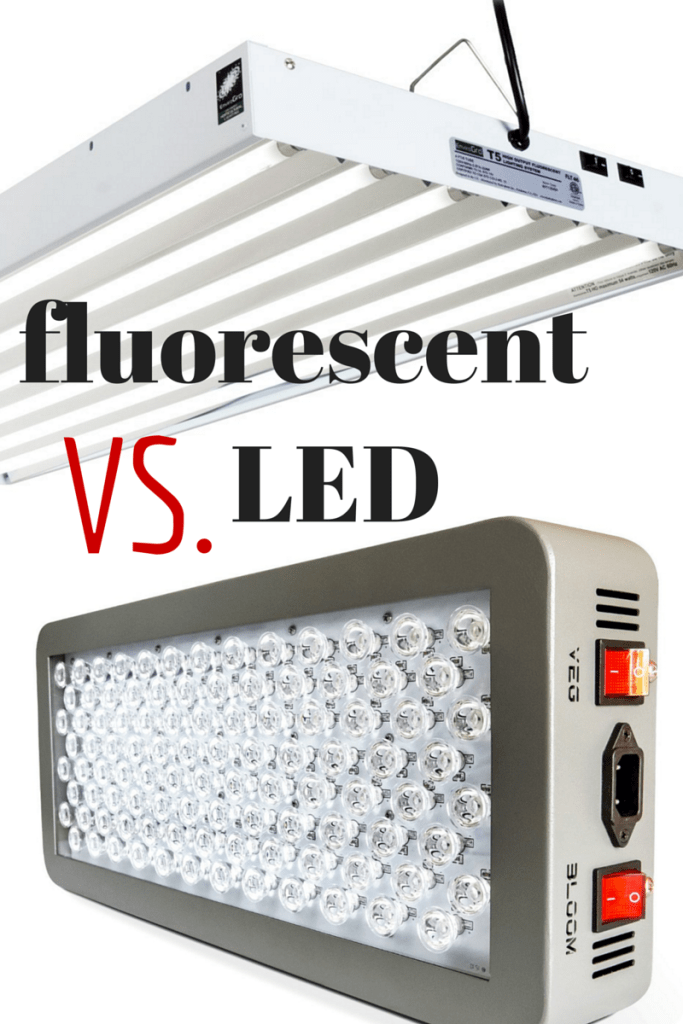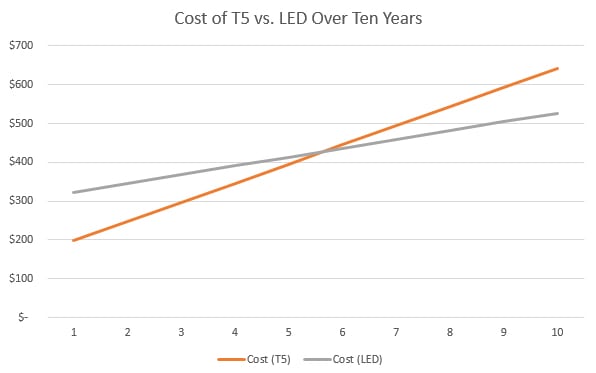Reader Chris wrote in several weeks ago, asking about LED Grow Lights.
Have you revisited LED Grow Lights lately? I want to start some transplants earlier than usual this year, and my normal method of raising transplants won’t work. I need to invest in some grow lights and I really don’t want to buy fluorescent tubes if there is a LED alternative available that doesn’t cost a fortune.
I wasted hours on the internet yesterday trying to find reliable information/recommendations, and came up with nothing. If you or anyone else out there has information, I would greatly appreciate it. Thanks!
Hi Chris!
Nick (Homebrew Husband) here. Erica knows I have a geeky appreciation for all things lighting, so she kicked this question over to me.
Like you, I’d much rather buy LEDs than florescent fixtures, but I also agree that at a certain point it has to make financial sense. LEDs are really starting to make sense for standard house lights, but what about grow lights?
When we upgraded our florescent grow lights last spring from old T12s to much-higher-efficiency T5s, I did some pretty extensive research and came to the conclusion that LEDs didn’t make sense for the home gardener unless you were growing a certain highly valuable cash crop entirely indoors.
Yeah, you know the crop I’m talking about.
In this kind of application, LEDs really are run at a quantity where their superior efficiency pays for itself quickly. LEDs also offer other advantages over fluorescents, such as the ability to control the spectral content of the light. This allows the indoor farmer to provide her plants with optimum lighting conditions at every phase of life, from seed to fruit (or – who are we kidding – bud).
Okay, but what about folks like us who really are just starting tomatoes (not “tomatoes”) a few weeks early. We want to save a dime or two on electricity and ideally avoid the toxic contents of a fluorescent tube. Are LEDs right for us?

LED vs. Fluorescent: The Numbers
Googling around a bit, I found LED grow light fixtures that seemed comparable in light output to the 2×4 foot, T5 fluorescent fixtures we use for anywhere from $300-$800. These LED fixtures consume anywhere from 150 to 300 Watts.
Fluorescent fixtures comparable to ours run about $150 and consume (with 6 x 54 Watt tubes) about 325 Watts.
Now let’s do some math.
Let’s square off a hypothetical 150 Watt, $300 LED vs a 325 Watt, $150 T5 fixture (keep in mind that this is the “best case” of everything I found for the LED to come out ahead).
At 15 cents per kWh for electricity (more expensive than up here in the Northwest but pretty close to the national average), you’d have to run these grow lights 12 hours a day for 475 days before the electricity savings is enough to put the LED ahead.
That’s equivalent to starting two sets of seedlings, each under lights for six weeks, every year for over five years.

Now frankly I’m not convinced that the smallest of LEDs would provide equivalent coverage. If you instead think of a $500, 200 Watt LED package, it’ll take you more than three times as long to reach the payoff.
Bottom Line: I’d estimate a realistic home gardener pay-off timeline of 5 to 10 years. The more your lights will be on, the faster LEDs will pay off in energy savings.
Obviously there are other factors here. LEDs do offer some additional control, particularly handy if you are growing the entire lifecycle of your plant under lights. They run cooler if you are dealing with a warmer climate. And there’s at least some hope that they are lower in toxicity in manufacture and disposal.
High power LEDs are still a developing technology and, as a grow-light, something of a niche product. At the price points we’re seeing, I think most home gardeners will be better served with high-efficiency fluorescent lights.
However, I do expect LED technology to continue to come down in price and would guess that within 3 years fluorescents will no longer be competitive.
Want to ask a question?
It’s easy, and if I can, I’ll try to answer it! Just follow these steps to make it easier for me to answer your question in a post like this or a Q&A round-up.
- Send me an email with “Question for Erica” in the subject line. (Even if it’s a Question for Nick.)
- Ask your question in one or two sentences.
- Start a new paragraph and provide any additional details that are relevant to your question.
Thank you!
15

For the more casual gardener, you can also consider full-spectrum compact fluorescents (Lee Valley sells them, and we plugged them into old IKEA clip-on lamps). Not as nice a set-up, but enough to get everything started for under 50$. We do intend to get a more intensive set-up going in the future, but until then, this is an excellent cheap patch-work job that fills our needs.
Good suggestion!
This is something I think a lot about and you’ve come up with a good compromise! I can do 50 bucks. Then if it doesn’t work out or I move onto another project (likely) like chocolate ganache cakes then don’t feel as guilty.
Super useful post!
Have you seen the LED shop lights Costco has been running on coupon? How do they compare to a T5?
My concern is that these drop-ins are not grow lights. They’ll work great for illumination (I’m considering replacing the few big tubes we have for just regular garage lighting) but aren’t going to have the spectra that a plant is going to thrive under. I haven’t seen any drop-in LED replacements for tube type fixtures that have that grow-light spectral content.
But you don’t need special spectra if you’re just starting seedlings.
You do to grow transplants…
From what I hae seen, and the opinion of the professionals I’ve talked to, the manufacturers of almost all LED lights lie like a rug. They claim that they are operating at a certain set of parameters, be it wattage, or spectrum etc. When you start looking at their claims, under scientific scrutiny, they don’t live up to the claim.
Ha, yes, I remember looking at LED grow lights and seeing a lot of things to the effect of “unlike other manufacturers, we never lie about our output!” and thinking to myself, “gee…now who am I supposed to trust now?”
How long are grow lights effective before you need to replace the bulbs?
6 weeks? If I get my tomatoes (and yes that’s really tomatoes – in CO some people still grow tomatoes :)) under lights ‘on time’ that will be end of Feb early March, but they can’t go out in the garden till at least mid May if I want to avoid snow and hail. Thanks for the thoughtful write up. I got lights last year and it was a might and day difference in successful seed starting – as in – hey, *everything* didn’t die. I even had plants to give away. So, all that to say thanks for all the good advice!
This ignores the lifespan. Fluorescents lose a little bit of light over time, but stay pretty close to rating until the tube fails. LEDs gradually lose output over time. The rated lifespan is when it’s decayed below 70% of its stated output. At which point you either have to keep using an increasingly dim fixture or junk the WHOLE thing.
LEDs are also considerably less standardized than fluorescents, whose ballasts and tubes will be readily available for years to come. Some LED parts vanish within 6 months. It’s a major headache.
Great post, useful and timely information, AND gave me a few needed laughs. Thanks!
I completely agree. LEDs are for specialized uses. T5 fluorescents are great for general seedling production. I grow about 3000 seedlings under T5s every year and they do a great job. An eight bulb T5 fixture has much better coverage than LED fixtures, which tend to be a lot smaller at the same output. When a bulb or ballast dies, I can easily replace it. With an LED array, repairs are more complex. The T5 fixtures will probably last me a lifetime.
Not directly related to LEDs, but wondering if you’ve tried winter sowing?
I’ve been growing seedlings under fluorescents for over 30 years. I must admit that up-front costs have been my main concern. I simply have never had the cash to invest in anything over the cheap junk from Walmart, Home Depot, etc. The four 2-bulb fluorescents shop lights (T12) I have now I’ve had since 1998. I purchased them on sale for $9.99 each. They use the cheap 12T bulbs that cost about $1.50 each in packs of 10 (vs. $5.00 each for T5). I still have 4 new bulbs in the pack, when I started using them in 2003. At that time I had a 65-member CSA and raised 1000’s of seedlings under them. Yes, I’m retired now and don’t grow as many plant I once did, but honestly folks, I do not any difference in my seedlings or the yield in the plants, even though the lights are supposed to lose intensity over the years. I replace ’em when they die. The difference between T8 and T12 in lumens is 2600 vs 2520, I assume the T5s are still more lumens. I can’t see the difference and it appears it doesn’t seem to matter to the plants either. Since I retired in 2010 I have kept details in Excel on my electric costs and pay attention to my kilowatt hrs. I just can’t see the difference in either the plants or the utility bill. Maybe I would see the difference in the $50.00 light fixture vs. the $10.00 one over say, 30 years, but I’m not going to live that long and I’m on a limited budget NOW. And of course there is a difference in that I’m using more electricity, but few consider the amount of energy it takes to manufacture the light fixture in the first place. I’d say keep what you have and stop with the buy new stuff.
Homebrew Hubby does it again. (Speaks truth. I’ve thought a lot about this too.)
With the T-5 bulbs do you combine cool and warm light bulbs? Is this even a thing for the T-5 bulbs? I am only noticing cool white or blue spectrum. Also I have inherited old fluorescent fixtures that I would like to use to get started this year. Can you put the T-5 bulbs in older fixtures?
LED prices are falling like a rock. 5000K light is advertised as “natural daylight”. With rebates prices might be comparable sooner than we think. The variety at Costco for screw in bulbs is really growing.
Hi
Any chance I can just put the planted seeds next to a southern window. I don’t have the money or space.
If that won’t work do you have any other suggestions on what to do?